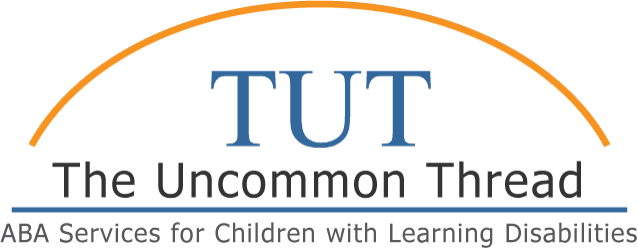“Animals are such agreeable friends – they ask no questions; they pass no criticisms.” – George Eliot
At The Uncommon Thread (TUT) we witness firsthand how pet therapy can be a heartwarming and effective way to support the development and well-being of children with autism. This unique approach uses the special bond between animals and children to nurture emotional, social, and cognitive growth. Whether it’s through regular interaction with a family pet or occasional visits from a therapy animal, the benefits of pet therapy are wide-ranging. Here are some of the wonderful ways pet therapy can help:

1. Boosted Social Skills
Children with autism often find social interactions challenging, but animals provide a friendly, non-judgmental way to practice social skills. Whether it’s learning to read a therapy dog’s wagging tail during a visit or recognizing a cat’s affectionate purr at home, interacting with animals helps children understand non-verbal cues like body language and facial expressions. Therapy animals also create opportunities for children to engage socially with peers and adults, making socializing feel more natural and fun.
2. Calmer and more Regulated Emotions
You won’t see many tantrums during pet therapy at TUT! The unconditional love that animals offer can help children with autism feel more at ease. Dogs, cats, and other animals provide a comforting presence that reduces anxiety and stress. Studies have shown that petting or spending time with an animal releases endorphins, lowers blood pressure, and produces a calming effect. All this helps children manage their emotions, which leads to a happier mood and a greater ability to cope with daily challenges.
3. Growing Empathy and Compassion
Caring for a pet or interacting with a therapy animal teaches children with autism empathy and compassion. Understanding an animal’s needs—whether feeding a pet at home or learning how to pet a therapy dog gently—encourages children to think about and care for others. These experiences can foster empathy and compassion, not just for animals, but for people as well.
4. Enhanced Communication
For non-verbal or minimally verbal children with autism, therapy animals can serve as a bridge for communication. Visits from therapy animals encourage children to express themselves, using gestures, sign language, or even AAC devices to interact with the animal. These moments can significantly boost communication skills, giving children the confidence to express their needs and desires.

5. Fostering Responsibility and Independence
Taking care of a family pet can teach children with autism valuable life skills, such as responsibility and independence. Even occasional interactions with therapy animals during visits can help children understand the importance of caring for others. Successfully feeding, grooming, or playing with an animal provides a sense of accomplishment that builds self-esteem and encourages independence in other areas of life.
6. Creating Routine and Stability
Children with autism thrive on routine and structure, and animals naturally bring these elements into a child’s life. Whether it’s the daily care of a family pet or the scheduled visits of a therapy animal, animals help establish consistency. The predictable interactions create a sense of security and stability that makes it easier for children to manage other daily routines.
7. Inspiring Play and Imagination
Animals inspire imaginative play in children with autism. Whether it’s pretending to be a vet with a family pet or engaging in creative games with a therapy animal during a session, animals encourage cognitive flexibility and creativity. These playful interactions not only bring joy but also help enhance problem-solving skills and cognitive development.
Pet therapy offers a joyful and enriching experience for children with autism, whether it involves a cherished family pet or visits from therapy animals. From improving social and communication skills to fostering empathy, independence, and emotional regulation, the benefits are profound. By incorporating animals into therapy, we create opportunities for growth, connection, and happiness that help children with autism thrive and reach their full potential.


